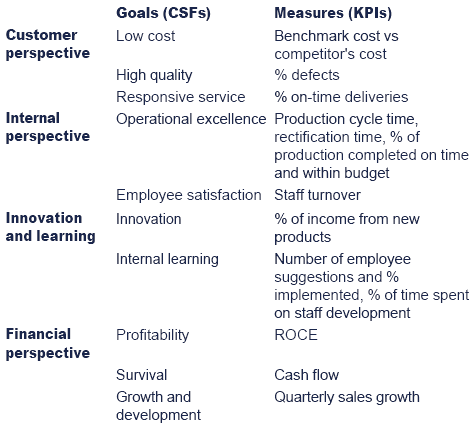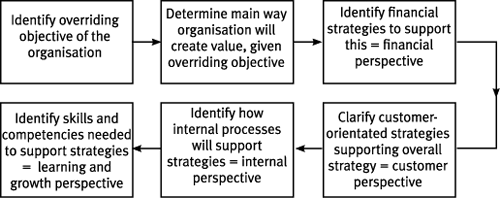The Balanced Scorecard
As part of performance management it is generally agreed that a system should include financial performance indicators and non-financial ones. The balanced scorecard is an attempt to incorporate both.
What is the balanced scorecard?
The balanced scorecard includes financial measures (these reveal the results of actions already taken) and non-financial measures (these are drivers of future financial performance). It includes external as well as internal information.
The balanced scorecard allows managers to look at the business from four important perspectives:
Within each of these perspectives a business should seek to identify a series of goals (CSFs) and measures (KPIs). These should be in line with the overall strategic objectives and vision of the organisation.
Illustration - Examples of goals and measures
A balanced scorecard for an electronics company could include the following goals and measures:

It would be beneficial to rank the goals and measures in order of importance.
Implementing the balanced scorecard
There are four essential activities which have to be executed rigorously if the implementation of the balanced scorecard is to succeed:
(1) Make the strategy explicit
The starting point in producing a balanced scorecard is identifying the strategic requirements for success in the firm.Typically, those strategic requirements will relate to products,markets, growth and resources (human, intellectual and capital).
For example, businesses like Dell may want to be low-cost producers achieving competitive advantage from selling undifferentiated products at lower prices than those of competitors, or a business may have a product development strategy to become a leader in technology and command a premium like Apple. Their strategy may also be to develop and maintain market share, like Microsoft, or their strategy may be to occupy the number-one or number-two position in their lines of business.
(2) Choose the measures
Performance measures have to be selected that clearly relate to the achievement of the strategies identified in the earlier process. As has been seen throughout the discussion of performance measures in this text, the selection of appropriate indicators and measures is critical.The selected measures form the goals that management communicates to staff as being important. Those goals are what staff will strive to achieve. If the wrong goals are selected then the firm may find itself doing the wrong things.
The general problem is that performance measures that relate to limited parts of the business can be very prone to inducing dysfunctional behaviour. For example, a firm might minimise its inventory holding in order to meet some inventory holding target - but at the expense of total operating costs.
(3) Define and refine
Management reporting systems and procedures need to be set up to track and report the measures regularly. This involves all the issues relating to the processing of data and the reporting of information discussed earlier in this text.
The precise requirements of reporting associated with the use of the balanced scorecard will make demands on both the management accounting and IT systems in an organisation. Fully satisfying those demands has a cost and sometimes compromises may have to be made in order to contain that cost.
All sorts of practical problems may be encountered in reporting on an indicator. For example, when reporting on revenue:
- How is revenue calculated and when is it recorded?
- Should it include the non-core business activity?
- Should revenue be reported under product, region or customer headings?
- How should inter-divisional transactions be reported?
Operating the management accounting system associated with the balanced scorecard requires that the things being reported should be defined and periodically refined.
(4) Deal with people
The balanced scorecard is an exercise in modifying human behaviour. It is its interaction with people that determines whether or not it will work.
Balanced scorecards can easily become a confusing mass of measures, some of which even contradict each other. There may be too many measures and action to achieve some of them may contribute to failure to achieve others. The measures may not always be prioritised.
To be effective, the measures contained in the scorecard should be limited in number, reasonably consistent and ranked in some order of priority. Further, performance measures should be aligned with the management structure. Career progression and remuneration should be appropriately linked to scorecard measure linked performance.Organisations which adopt a balanced scorecard but continue to reward managers on the basis of a narrow range of traditional financial measures are likely to be disappointed by the results.
Practical example of scorecard implementation
One example reported in management literature of how the balanced scorecard might be applied is the US case of Analog Devices (a semi-conductor manufacturer) in the preparation of its five-year strategic plan for 1998-1992.
Analog Devices had as its main corporate objective: 'Achieving our goals for growth, profits, market share and quality creates the environment and economic means to satisfy the needs of our employees,stockholders, customers and others associated with the firm. Our success depends on people who understand the interdependence and congruence of their personal goals with those of the company and who are thus motivated to contribute towards the achievement of those goals.'
Three basic strategic objectives identified by the company were market leadership, sales growth and profitability.
The company adopted targets as follows:
Customer perspective
- Percentage of orders delivered on time: a target was set for the five-year period to increase the percentage of on-time deliveries from 85% to at least 99.8%.
- Outgoing defect levels: the target was to reduce the number of defects in product items delivered to customers, from 500 per month to fewer than 10 per month.
- Order lead time: a target was set to reduce the time between receiving a customer order to delivery from 10 weeks to less than three weeks.
Internal perspective
- Manufacturing cycle time: to reduce this from 15 weeks to 4 to 5 weeks over the five-year planning period.
- Defective items in production: to reduce defects in production from 5,000 per month to fewer than 10 per month.
Learning and innovation perspective
- Having products rated 'number one' by at least 50% of customers, based on their attitudes to whether the company was making the right products, performance, price, reliability, quality, delivery, lead time, customer support, responsiveness, willingness to co-operate and willingness to form partnerships.
- The number of new products introduced to the market.
- Sales revenue from new products.
- The new product sales ratio: this was the percentage of total sales achieved by products introduced to the market within the previous six quarters.
- Average annual revenues for new products in their third year.
- Reducing the average time to bring new product ideas to market.
Financial targets were set for revenue, revenue growth, profit and return on assets, but the idea was that the financial targets would flow from achieving the other targets stated above.
Analog Devices sought to adopt financial and non-financial performance measures within a single system, in which the various targets were consistent with each other and were in no way incompatible.
Strategy mapping
Strategy mapping was developed by Kaplan and Norton as an extension to the balanced scorecard and to make implementations of the scorecard more successful.
The steps involved in strategy mapping

- At the head of the strategy map is the overriding objective of the organisation which describes how it creates value. This is then connected to the organisation's other objectives, categorised in terms of the four perspectives of the balanced scorecard, showing the cause-and-effect relationships between them.
- The strategy map helps organisations to clarify, describe and communicate the strategy and objectives, both within the organisation and to external stakeholders by presenting the key relationships between the overall objective and the supporting strategy and objectives in one diagram.
Issues when implementing the strategy map:
- Organisations have often found it difficult to translate the corporate vision into behaviour and actions which achieve the key corporate objectives.
- In practice, many employees do not understand the organisation's strategy, and systems such as performance management and budgeting are not linked to the strategy.
|
Created at 6/13/2012 3:11 PM by System Account
(GMT) Greenwich Mean Time : Dublin, Edinburgh, Lisbon, London
|
Last modified at 11/14/2012 9:56 AM by System Account
(GMT) Greenwich Mean Time : Dublin, Edinburgh, Lisbon, London
|
|
|
|
 |
Rating
:
|
 Ratings & Comments
(Click the stars to rate the page) Ratings & Comments
(Click the stars to rate the page)
|
 |
Tags:
|
|
|
|
|